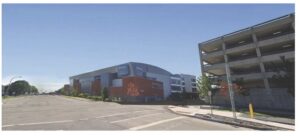April 18, 2023
The Wall Street Journal reports North American cities want less parking, not more
Mayor Restaino proposes approximately $30 million in new parking to support the proposed location of his event center and park plan. This is despite the underutilized, city-owned parking that already exists next to the perfect location for his events center: Near Third Street restaurant, bars, and other commercial establishments. The Rainbow Mall parking ramp is already there. It is already city owned. And it’s half empty (or more) most of the time.
A rendering of how a new event center might look next to the Rainbow Mall parking garage on Niagara Street.
This $30 million for additional parking is in addition to an estimated $20 million that the city will likely pay to acquire, through eminent domain, the private property owned by Niagara Falls Redevelopment (NFR), and the millions more in legal fees and other costs for a legal battle that may take a decade.
The foolish construction of additional parking when other lots sit empty would be in total opposition to national trends. Consider the following:
- On April 2, 2023, The Wall Street Journal published an article titled “America Has Too Much Parking. Really,” which began:
For decades, American cities have had a parking problem: too much of it.
Countless residential parking spots go unused, and many downtown garages sit half empty… Recognizing this, cities are shrinking the number of spaces, freeing up the land for other uses, with far-reaching consequences.
Are Mayor Robert Restaino and the City of Niagara Falls really going to buck the trend and spend tens of millions it doesn’t have to add more parking when an underutilized parking garage next to a city-owned lot already exists?
- According to The Wall Street Journal, there’s a trend taking American cities by storm. More and more towns are getting rid of parking spaces, opting for freeing land for new developments. Downtown parking garages in most major U.S. and Canadian cities have at least 20% vacancy during weekdays and on weekends during special events. Ride sharing, the rise of remote work, and other factors, have resulted in countless residential parking spots going unused.
- Buffalo is one of the cities cited in The Wall Street Journal The Journal says there is major evidence supporting the thought that cities who remove parking requirements improve quality of life and also the sustainability of the community. This, the Journal states, has proven to be true in many cities, including Buffalo, which eliminated parking requirements for new developments in 2017. Since then, Buffalo has seen a revitalization of its downtown area, and population grew for the first time since the 1950 Census.
- According to the Journal:
In 2017, Buffalo, N.Y., became one of the first big cities to eliminate minimum parking requirements citywide. “The priority was people are looking for a place to live, not to park,” said Brendan Mehaffy, the city’s director of strategic planning.
Developments approved in the first two years after the change provided 21% fewer spots than would have been required under the old rules, according to a study by the University of Buffalo. It also contributed to a development boom in the city’s downtown that helped arrest decades of decline.
The latest once-a-decade Census count, done in 2020, showed Buffalo’s population grew for the first time since the 1950 Census.
One former parking lot on the east side of downtown is now a grocery store and 201 units of affordable housing, with limited on-site parking.
Buffalo has since become a model. Mr. Mehaffy frequently speaks to planners elsewhere looking to replicate the city’s parking policy.
- In line with this trend, walkable communities have dominated mainstream urban and suburban planning for over 30 years. With Niagara Falls attracting approximately 12 million tourists a season, many experts believe walkability is a key factor in creating a vibrant atmosphere that keeps tourists engaged for longer and repeat stays. In many destination cities, cars are not even part of the equation, focusing more on local ground transportation. Thus, fewer parking facilities next to attractions are needed. The benefit to local businesses is enormous. Parking garages promote the feeling that one should park next to their destination, leaving many unseen shops and businesses nearby. By abandoning cars, tourists would become immersed in Niagara Falls natural beauty and all of the entertainment and leisure activities involved.
One final note to consider: How useful will all this excess parking be in the future, with ride-hailing and other new technologies – including the predicted emergence of AI-assisted valet parking, where your car can be dropped off to you with a few clicks on your phone?
This is why the location on Niagara Street and Third Street makes so much sense for an events center… and why the “Two-Project Solution” makes so much sense for the City of Niagara Falls.
###
